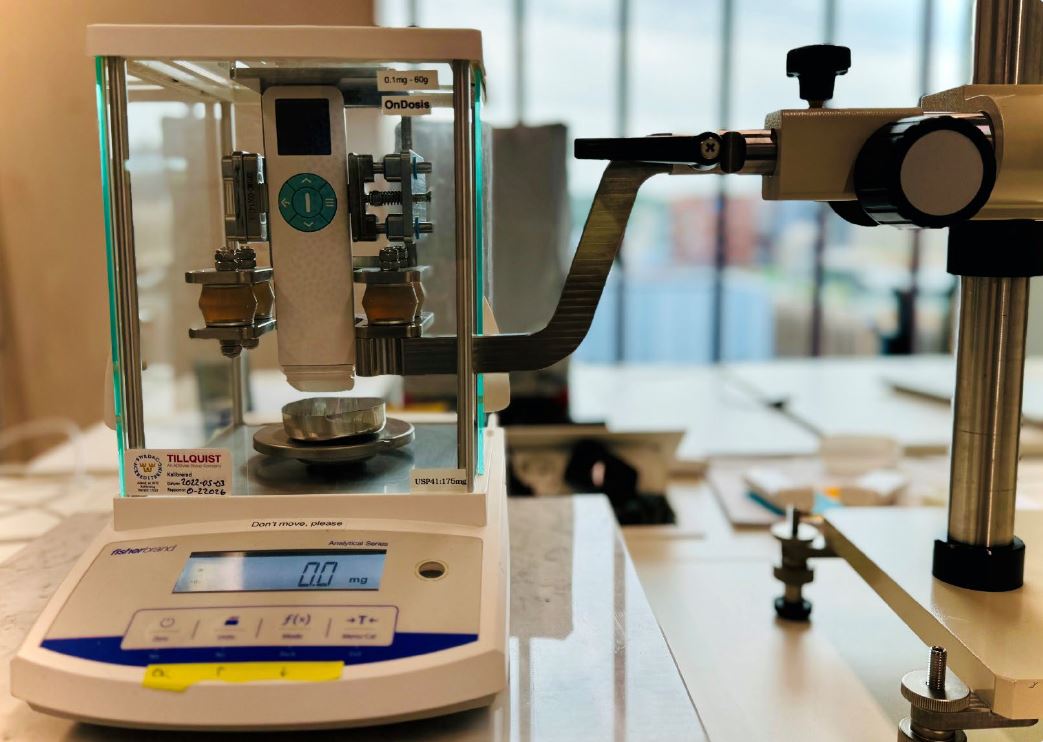Achieving individualised dosing with pellet formulations combined with an innovative device technology

This poster was presented at the EuPFI Conference 2024 by OnDosis AB:
Background & Objective
Today, oral solid medicines are often presented as relatively large tablets or capsules at one or a few dose strengths that do not offer the possibility for fine dose adjustments. The possibility to adjust dose sizes according to the needs of a specific patient is often desirable in pharmacological treatment of children where treatment efficacy needs to be carefully balanced against side-effects. Alternative solid dosage forms such as small pellets have the potential to offer more flexibility in dosing and easier titration1, as well as more precise doses in-between the doses offered in currently available solid formulations. Providing the medicine in the form of small pellets can also improve medicine-acceptance in children, who not seldom have difficulties swallowing regular-size tablets and capsules2.
The aim of the present study was to evaluate the dosing accuracy and precision of an innovative device technology that was designed to enable individualised and flexible dosing of medicines formulated as pellets.
Materials & Methods
The technology under evaluation is a handheld electromechanical device intended to hold and dispense flexible doses of medicines formulated as pellets or granules (OnDosis Dosage Manager, currently under development by OnDosis AB, Mölndal, Sweden) (Figure 1). The technology targets addressing: precise and flexible dosing, safe use in home environment (minimising dose errors), compliance and adherence, child-tamper resistance, and pill-swallowing difficulties.

The device consists of a reusable control unit and a replaceable medicine-containing multi-dose cartridge (typically holding medicine corresponding to one month of treatment, pre-filled at point of manufacture). The control unit has an embedded software that controls a flexible dispensing mechanism. Each cartridge consists of two chambers, from which one or two pellet formulations can be dispensed simultaneously with adjustable dose sizes at predetermined fine dose increments within safety limits determined for each specific medicine.
Two equivalent control units were used in the study.
Forty-four (44) cartridges were filled with either 10.4 g (‘high’ dose cartridges, n=22) or 1.7 g (‘low’ dose cartridges, n=22) of placebo pellet formulation, distributed evenly between the two chambers of the cartridge. The pellets were produced by fluid bed coating technology and had the following characteristics: mean pellets size 654μm [D50]; span value 0.154; bulk density 0.86 (Figure 2). Free talc was added to the formulationto control flowability and electrostatic.
Thirty consecutive doses were dispensed from each cartridge, representing either a ‘high’ (300 mg target delivered dose, TDD) or a ‘low’ (50 mg TDD) dose size (total mass) (Figure 3). Each dispensed dose was weighed using a calibrated laboratory balance with 0.01 mg accuracy (Sartorius Secura 125-1CEU, Sartorius Lab Instruments GmbH & Co. KG, Germany; Ohaus EX225D, Ohaus Corporation, USA). For half of the cartridges (n=22), the mass of the total dispensed dose (sum of pellets dispensed from both cartridge chambers) was recorded. For the other half (n=22), pellets dispensed from each chamber (corresponding to 50% of the total TDD, i.e. 150 mg and 25 mg, respectively) were weighed separately.
Results
The dispensing performance for ‘high’ and ‘low’ doses was Mean 310.5 mg (SD 7.1 mg, N=11 cartridges, n=324 dispensed doses) and Mean 49.1 mg (SD 1.9 mg, N=11, n=329), respectively, which represents on average 103% and 98% of the TDD (Figure 5-6). Out of 653** total recorded dispenses, the mass recorded for three (3) individual doses were regarded as abnormal (but included in calculations of Mean and SD): one dispense from one ‘high’ dose cartridge (dose < TDD) and two dispenses from one ‘low’ dose cartridge (dose > TDD) (Figure 5). Abnormal values are deemed to be due to a minor device mechanism issue of the specific prototype devices used in the study.
The dispensing performance per cartridge chamber for the ‘high’ dose was Mean 159.3 mg (SD 5.3 mg, N=11, n=330) and Mean 158.9 (SD 5.2 mg, N=11, n=322) for the ‘high’ dose, which represents on average 106% of the TDD. The corresponding values for the ‘low’ dose were Mean 24.8 mg (SD 1.6 mg, N=11, n=330) and Mean 25.0 (SD 2.1 mg, N=11, n=328), representing on average 99% and 100% of the TDD, respectively (Figure 7). Out of 652** total recorded dispenses, four (4) abnormal values (1 ‘high’ and 3 ‘low doses; dose < TDD) were observed.

Download the full poster on “Achieving individualised dosing with pellet formulations” here
(click the picture to download the poster)
Source: OnDosis AB, Emelie Svensson, Linus Engdahl, Abraham Manuel James, OnDosis AB, Mölndal, Sweden,
Poster: Achieving individualised dosing with pellet formulations combined with an innovative device technology






